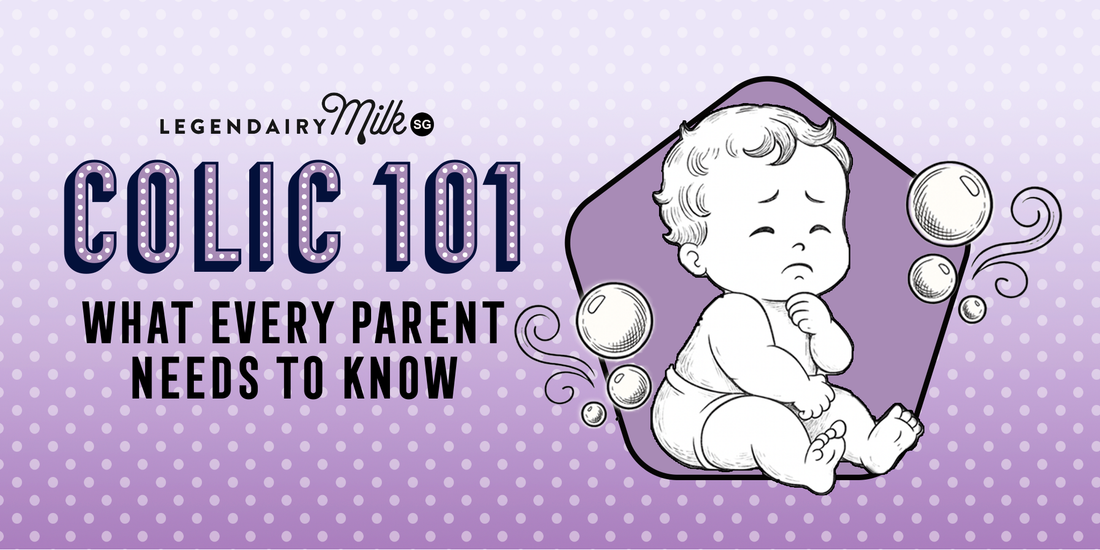
Colic 101: What Every Parent Should Know
Share
Understanding Colic
If your baby cries for long stretches, pulls their knees to their chest, kicks, or seems especially gassy and restless, you’ve probably heard the word colic.
Colic is a collection of symptoms. For parents, it can be exhausting and discouraging, but here’s the reassuring part: in most cases, there are real reasons behind the symptoms, and many of them can be addressed.
When Milk Feels Out of Balance
One possible trigger of colicky symptoms is lactose overload.
This often happens with a strong or abundant milk supply. Babies may fill up on the thinner, more sugar-rich milk at the start of a feed without getting enough of the creamier, fat-rich milk that follows. It’s not a sign of poor quality milk or lactose intolerance — just an imbalance in what baby is receiving.
Tips to try:
- Stick to one breast per feed so baby drains it fully.
- Use breast compressions to help the creamier milk flow.
- If you have a forceful let-down, express a little milk before latching baby.
- Add healthy fats like olive oil, flax, butter, or fish oil to your meals to support milk fat.
Diet Clues: Sugar & Caffeine
Sometimes colic is linked to what’s in your own diet. Both sugar and caffeine can slip into breast milk and affect baby’s mood, digestion, and sleep.
What may help:
- Cut down on processed snacks and sugary drinks.
- Limit coffee, tea, soda, or energy drinks.
- Even small dietary shifts can lead to noticeable changes in baby’s comfort.
When It’s More Than Colic: GERD
Some babies who seem “colicky” are actually dealing with reflux (GERD), when stomach acid flows back into the esophagus and causes pain.
Signs may include:
- Frequent spit-up or vomiting
- Arching backward in distress
- Fussing or pulling off at the breast
- Acting hungry but feeding poorly
What you can do:
- Keep baby upright during and after feeds.
- Consult your pediatrician about options ranging from feeding adjustments to medical treatment.
- Seek help early — GERD can impact feeding success and milk supply if left unchecked.
Food Sensitivities & Allergies
Colicky behavior may also be tied to reactions from foods in your diet. The most common culprits are dairy, soy, wheat, corn, eggs, and peanuts.
Next steps:
- Speak with your healthcare provider before making dietary changes.
- Keep a food and symptom log to track patterns.
- Try removing one food group at a time (starting with dairy) for a few weeks to see if baby improves.
Feeding Mechanics & Body Tension
Sometimes colic is less about what your baby eats, and more about how.
Oral ties such as tongue-tie or lip-tie can cause a shallow latch, poor milk transfer, and lots of swallowed air, which leads to gas and fussiness. An assessment from an IBCLC or pediatric dentist can help, and if necessary, a simple procedure (frenotomy) can improve feeding.
Body tension can also contribute. Babies who experienced a difficult birth or have tight muscles may arch, prefer one side, or resist lying flat. Gentle therapies like craniosacral therapy or infant chiropractic care may ease tension and support digestion.
The Gut Microbiome & Colic
Your baby’s gut is still developing, and its balance of bacteria plays a big role in digestion, immunity, and comfort.
Factors like cesarean birth, antibiotics, or limited breastfeeding can alter this delicate ecosystem, sometimes leading to more crying or digestive upset. Supporting the microbiome through breast milk, probiotics, and minimizing unnecessary antibiotics may help restore balance.
Comfort Measures That Work
Beyond feeding changes, sometimes the simplest comforts go a long way. Try:
- Babywearing to ease gas after feeds
- The “colic carry” position (baby tummy-down along your arm)
- Gentle rocking, bouncing, or rhythmic motion
- Warm baths or infant massage
- Frequent burping during and after feeds
The closeness and reassurance you give your baby can be just as powerful as any feeding adjustment.
Probiotics for Tummy Relief
Studies suggest certain probiotic strains may reduce crying in colicky babies.
The most researched are:
- Lactobacillus rhamnosus GG
- Lactobacillus reuteri
One study showed L. reuteri helped decrease spit-ups, bloating, and crying time. These probiotics can support gut balance and are available in Legendairy Milk’s Organic Probiotic Drops.
A Final Word for Parents
Caring for a colicky baby can feel relentless, but it does not mean you are failing. Colic is almost always temporary, and there are many supportive steps you can take to ease your baby’s discomfort.
Resources
- https://llli.org/breastfeeding-info/foremilk-and-hindmilk/
- https://www.nationwidechildrens.org/conditions/gastroesophageal-reflux-disease-gerd-in-infants
- https://my.clevelandclinic.org/health/diseases/17931-tongue-tie-ankyloglossia
- Borre YE, et al. (2014). Microbiota and the gut-brain axis. Nutr Rev.
- Sung V, et al. (2018). Probiotics to prevent or treat excessive infant crying. JAMA Pediatrics.
- Rhoads JM, et al. (2018). Infant colic: New insights into an old problem. J Pediatr Gastroenterol Nutr.
- https://pubmed.ncbi.nlm.nih.gov/21114493
- https://www.sciencedirect.com/science/article/pii/S0965229921001229
- https://llli.org/breastfeeding-info/tongue-lip-ties
- https://www.balancechiroandrehab.com/blog/b48zpqv5k2h6tjknetmcbmaha6m450
